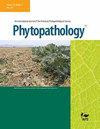求助PDF
{"title":"Integrative Elements Repeatedly Captured the Phaseolotoxin Biosynthesis Gene Cluster and Invaded <i>Pseudomonas syringae</i> Multiple Times.","authors":"Luiz Orlando de Oliveira, Hugo Vianna Silva Rody, Selene Aguilera, Jesús Murillo","doi":"10.1094/PHYTO-01-25-0017-R","DOIUrl":null,"url":null,"abstract":"<p><p>Phaseolotoxin is a virulence factor of <i>Pseudomonas amygdali</i> pv. <i>phaseolicola</i> (Pph) and <i>P. syringae</i> pv. <i>actinidiae</i> (Psa). Herein, we explore the evolutionary history of a genomic island (Tox island) composed of an integrative element (GInt) carrying the 23-gene cluster (Pht cluster) for biosynthesis of phaseolotoxin and toxin resistance. Our analyses indicate that the Pht cluster has been acquired, either naked or associated with a GInt, on seven independent occasions by four phylogroups of the <i>P. syringae</i> complex (Pph, Psa, <i>P. caricapapayae</i>, and <i>P. syringae</i> pv. <i>syringae</i>) and the phylogenetically distant rhizobacterium <i>Pseudomonas</i> sp. JAI115. The Pht cluster was independently captured by three distinct GInt elements, suggesting specific mechanisms for gene capture. Once acquired, the Tox island tends to be stably maintained, evolving with the genome. The likely evolutionary trajectory of the Tox island within Pph and Psa involved (i) acquisition by Pph; (ii) transfer of the Tox island from Pph to Psa biovar 1; (iii) independent acquisition from unknown sources of a different version of the Tox island by Psa biovar 1, generating a second toxigenic lineage; (iv) independent acquisition from unknown sources of a third version of the Tox island by Psa biovar 6; and (v) replacement of the Tox island in Pph by a distantly related GInt, generating nontoxigenic isolates. These findings underscore the potential role of phaseolotoxin in bacterial fitness and contribute to our understanding of the evolutionary dynamics of mobile genetic elements and virulence evolution in bacterial plant pathogens. [Formula: see text] Copyright © 2025 The Author(s). This is an open access article distributed under the CC BY-NC-ND 4.0 International license.</p>","PeriodicalId":20410,"journal":{"name":"Phytopathology","volume":" ","pages":"1086-1096"},"PeriodicalIF":3.1000,"publicationDate":"2025-09-01","publicationTypes":"Journal Article","fieldsOfStudy":null,"isOpenAccess":false,"openAccessPdf":"","citationCount":"0","resultStr":null,"platform":"Semanticscholar","paperid":null,"PeriodicalName":"Phytopathology","FirstCategoryId":"97","ListUrlMain":"https://doi.org/10.1094/PHYTO-01-25-0017-R","RegionNum":2,"RegionCategory":"农林科学","ArticlePicture":[],"TitleCN":null,"AbstractTextCN":null,"PMCID":null,"EPubDate":"","PubModel":"","JCR":"Q2","JCRName":"PLANT SCIENCES","Score":null,"Total":0}
引用次数: 0
引用
批量引用
Abstract
Phaseolotoxin is a virulence factor of Pseudomonas amygdali pv. phaseolicola (Pph) and P. syringae pv. actinidiae (Psa). Herein, we explore the evolutionary history of a genomic island (Tox island) composed of an integrative element (GInt) carrying the 23-gene cluster (Pht cluster) for biosynthesis of phaseolotoxin and toxin resistance. Our analyses indicate that the Pht cluster has been acquired, either naked or associated with a GInt, on seven independent occasions by four phylogroups of the P. syringae complex (Pph, Psa, P. caricapapayae , and P. syringae pv. syringae ) and the phylogenetically distant rhizobacterium Pseudomonas sp. JAI115. The Pht cluster was independently captured by three distinct GInt elements, suggesting specific mechanisms for gene capture. Once acquired, the Tox island tends to be stably maintained, evolving with the genome. The likely evolutionary trajectory of the Tox island within Pph and Psa involved (i) acquisition by Pph; (ii) transfer of the Tox island from Pph to Psa biovar 1; (iii) independent acquisition from unknown sources of a different version of the Tox island by Psa biovar 1, generating a second toxigenic lineage; (iv) independent acquisition from unknown sources of a third version of the Tox island by Psa biovar 6; and (v) replacement of the Tox island in Pph by a distantly related GInt, generating nontoxigenic isolates. These findings underscore the potential role of phaseolotoxin in bacterial fitness and contribute to our understanding of the evolutionary dynamics of mobile genetic elements and virulence evolution in bacterial plant pathogens. [Formula: see text] Copyright © 2025 The Author(s). This is an open access article distributed under the CC BY-NC-ND 4.0 International license.
整合元件多次捕获相毒素生物合成基因簇,多次入侵丁香假单胞菌。
相毒素是杏仁假单胞菌的毒力因子。phaseolicola (Pph)和p.s ynringae pv。actinidiae (Psa)。在此,我们探索了一个基因组岛(Tox岛)的进化历史,该基因组岛由一个携带23个基因簇(Pht簇)的整合元件(GInt)组成,用于生物合成相毒素和毒素抗性。我们的分析表明,Pht簇在7个独立的场合被丁香假单胞菌(Pph、Psa、P. caricapapayae和P. syringae pv)的4个系群(Pph、Psa、P. caricapapayae和P. syringae pv)获得,要么是裸的,要么是与GInt相关的。丁香科)和在系统发育上距离较远的根细菌假单胞菌。Pht簇被三个不同的GInt元件独立捕获,这表明基因捕获的特定机制。一旦获得,托克斯岛倾向于稳定地维持,与基因组一起进化。Pph和Psa中Tox岛可能的进化轨迹涉及:i) Pph的获取;ii)将托克斯岛从Pph转移到Psa生物变种1;iii) Psa biovar 1从未知来源独立获取不同版本的Tox岛,产生第二个产毒谱系;4) Psa biovar 6从未知来源独立获取第三个版本的Tox岛;5) Pph中的Tox岛被一个远亲GInt取代,产生不产毒的分离株。这些发现强调了相毒素在细菌适应性中的潜在作用,并有助于我们理解细菌植物病原体中移动遗传元件的进化动力学和毒力进化。
本文章由计算机程序翻译,如有差异,请以英文原文为准。

 求助内容:
求助内容: 应助结果提醒方式:
应助结果提醒方式:


